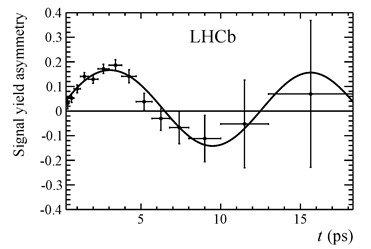Precise measurement of the unitarity triangle angle β.
Today at Les Rencontres de Physique de la Vallée d’Aoste, La Thuile, Italy, the LHCb collaboration presented an important result in our quest to understand the nature and origin of CP violation, which is a difference in behaviour between matter and antimatter. The result, derived from a careful analysis of the full run 1 data sample, is a measurement of the angle β of the ‘unitarity triangle’. This triangle is a geometrical representation of CP violating and associated parameters in the Standard Model. One side is defined to have unit length, the other two sides and three angles can be measured independently in different decays of beauty hadrons. It is the task of experimental physicists to measure these properties and see if they provide a consistent description of the triangle. Any discrepancy would point to signs of New Physics beyond the Standard Model. LHCb has already performed the world’s most precise measurements of γ, one of the other triangle angles, see 11 September 2014 news, and the mixing frequency of Bs mesons, see 7 November 2012 news, which is an essential ingredient for the determination of the side opposite to the angle γ.
The unitarity triangle is shown in the above left figure, with each experimental input represented by a coloured region. The result for β is given by the hatched blue diagonal band, marked as sin2βLHCb. The measurement is made from studying the decays of about 41500 B0 and B0 mesons to J/ψ and Ks0 mesons. The B0 mesons can decay to J/ψKs0 in two ways. They can decay directly to J/ψKs0 or they can oscillate, see 7 November 2012 news, into their antimatter partners B0 which in turn decay also to J/ψKs0. (This possibility of two paths in the decay process is a B physics analogue of the classical quantum mechanics two-slit experiment, which is described in this pedagogical video). The interference between the amplitudes for the two decay paths results in a time-dependent asymmetry between the decay time distributions of B0 and B0 mesons, as seen in the right image above. The oscillation amplitude measures sin2β, and gives the magnitude of CP violation present in the process. A value of sin2β=0 would indicate no CP violation. LHCb physicists announced today the value of sin2β=0.731±0.035±0.020, which is consistent with the geometrical expectation provided by the measurements of the other parameters of the unitarity triangle, and hence with the predictions of the Standard Model itself.
This result also confirms earlier measurements of the same quantity performed by the e+e– collider B factory experiments BaBar and Belle. These experiments were constructed specifically to measure sin2β. Their results were vital in confirming the broad validity of the Standard Model description of CP violation and led to the award of the 2008 Nobel Prize of Physics to the Japanese theorists M.Kobayashi and T.Maskawa, who had been central in developing this description. The solid blue diagonal band shows the new world combination of the B factory measurements with the new LHCb result.
Although the LHCb result for the angle β is not yet as precise as the combined result coming from the average of the B-factory measurements, it is similar in precision to the J/ψKs0 analyses of the individual experiments. It has been long-known that this measurement is a priori more difficult to perform in a hadron collider, such as the LHC, but the new result presented at La Thuile is an emphatic statement that LHCb can significantly contribute to our knowledge of this fundamental parameter. A still more precise result will be achievable with the data to be collected in run 2, which will allow for more stringent tests of the Standard Model.
Read more in the LHCb presentations at La Thuile, in the LHCb publication and in the CERN Courier article.


